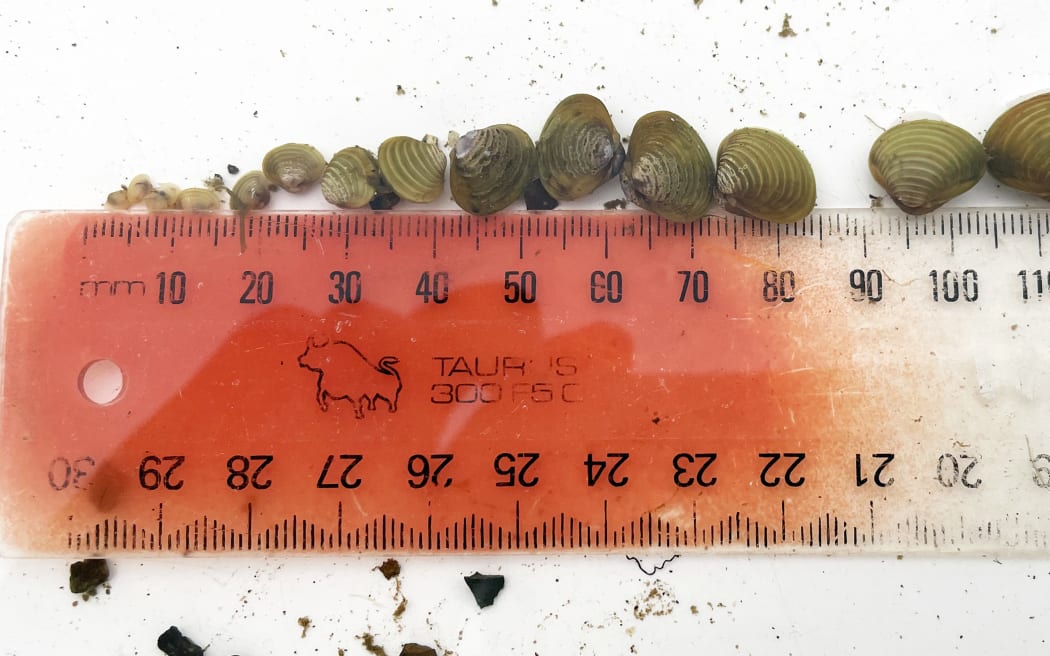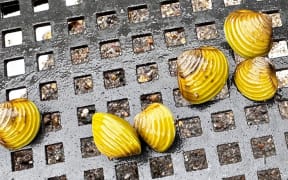
The Gold clam (Corbicula fluminea) is also known as the Asian clam. Photo: Supplied/ Ministry for Primary Industries
The discovery of the highly invasive and destructive gold clam in the Waikato River is a shock for Endangered Species Foundation chairperson Stu Muir.
Its arrival is just yet another species arriving in Aotearoa with "dire consequences" for native biodiversity, he says.
The discovery at Bob's Landing near Karapiro has created fears for the survival of native freshwater mussels - Kākahi - and the wider ecosystem in the awa.
The clams can produce up to 400 offspring a day and are hermaphrodites, meaning each animal has both male and female reproductive organs and can self fertilise.
"They've monitored it up and down the river from that point and seen it spread about 45 kilometres from that point which is alarming... we really have to - individually and collectively - be really, really careful about how we how we ship stuff, how we use our water. If we're boating, if we're fishing, you know, take all of those precautions that we used in other invasions."
It was not yet known how it arrived.
The major question was what a fight against the clam would look like as there have been no successful eradications around the world, Muir said.
"That's major worry and especially when it can breed so prolifically. Up to 70,000 spat for one mussel in a year, and obviously everything flowing from that far up the river will end up down here at the mouth of the Waikato River.
"Kākahi is is is one of our our our major species down here on the river. It's a good indicator of the biodiversity and the health of our white bait species and other things and any threat to that - as you know, our biodiversity is all connected - and it could have major repercussions.
"But at this moment, we're really working with MPI and DOC ... all of the all of the agencies are are sort of trying to collaborate to get the heads around what it is, where it is and what we can do about it."
Those organisations were moving fast, Muir said.
"In this scenario, the studies overseas have shown that, particularly in America, that the clam has out competed the the native mussels and they have attributes very similar to ours.
"Also the way that they transfer organic matter could potentially be a problem. Obviously they absorb nutrients, but as they absorb them they also release them, and if they're releasing them at a greater rate than they absorb them, that can have have major effects.
"They can pretty much colonise anything as far as we know at this point. And that's a really scary thing. It's not something that would necessarily be easily contained and if people are using boats in Karapiro, you know, they get their water in their bilge, that sort of thing. If they then go to another water source, the potential of spat or live mussels being transferred is huge and that's probably one of my biggest concerns at the moment."
Part of the problem included the size of the juveniles, Muir said - 1mm, transparent, and "virtually invisible".
"The clams are obvious when you see them because they're not like anything else and they can be easily killed, but it's more the transfer of the spat, of the the juveniles, that's the major worries. So if you get home with your boat, make sure that you that you wash it out thoroughly. If you're in urban areas often that water, it's chlorinated, so that that would be good. Don't do it around storm waters, obviously."
Fishing gear should be washed thoroughly and neoprene frozen to kill any in the residual water.
The Ministry of Primary Industries also had good information on its website, Muir said.



